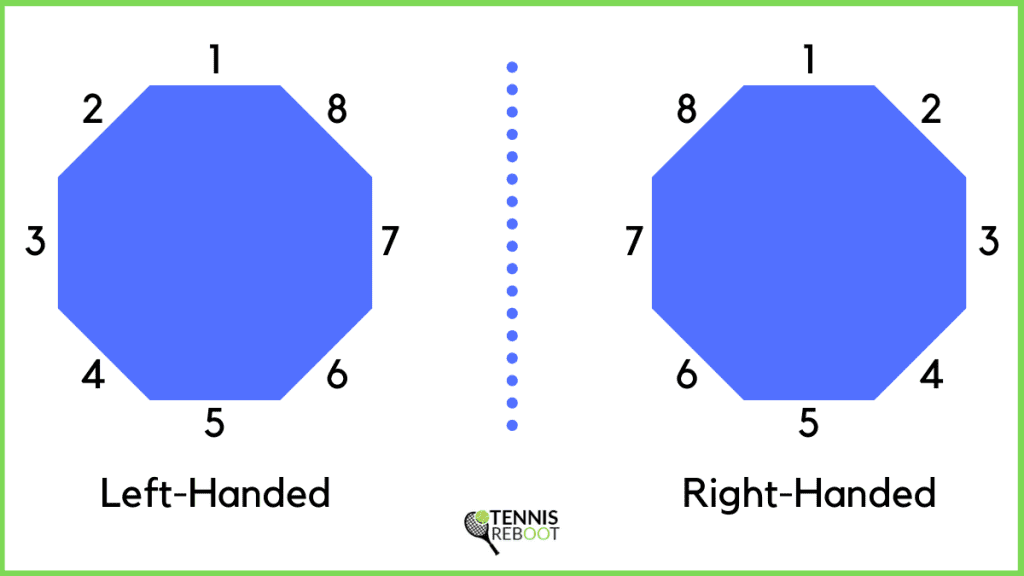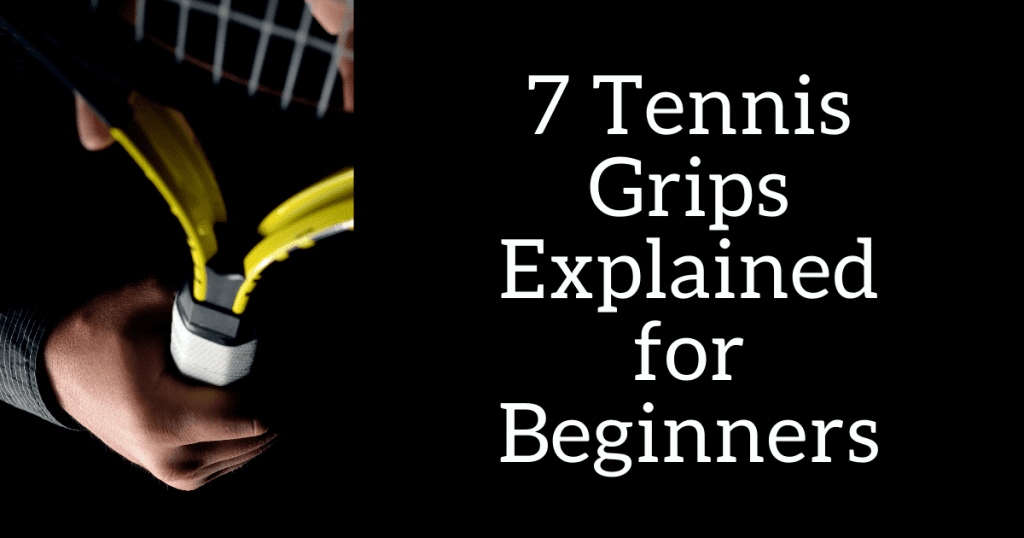You’ve spent a bit of time casually playing tennis with friends because you enjoy it. You might even be known within your friend group as the best player. What kind of tennis grip are you using for your forehand? Eastern? Semi-Western? Do you know what those terms mean?
Unfortunately, many beginner tennis players aren’t properly informed of the different hand placements or how to maintain their grips.
Depending on your style of play, you might benefit greatly from switching up how you grip your racket and the grip material used.
Contents
Anatomy of the Racket Handle
Take a look at the picture below. It’s a picture of the butt of any tennis racket.
Tennis racket handles are an octagonal shape and each of the 8 sides is known as a bevel. Each of the bevels has a corresponding number.
Knowing the numbers of the bevels will allow you to understand the many types of grips used and where to place your hand to engage that type of racket positioning.

We have seven grips to tell you about and this knowledge might help you become more comfortable with your groundstrokes and elevate your game.
Forehand Tennis Grips

Topspin is generated by a more closed racket face.
Continental Grip (Forehand and Backhand)
The Continental grip is often what is taught to beginners as it can be used for forehands and backhands. It’s a great place to start when learning the game as it places the racket in a neutral position in your hand.
Using the bevel picture above, your index finger knuckle is placed above bevel 2. A familiar phrase to easily get your hand into this position is to “shake hands with the racket.”
This grip is often used for serves, volleys and overheads. It’s also often used to teach a one-handed backhand whether hitting over the ball (topspin) or hitting under the ball (slice).
Eastern Forehand Grip
One knuckle rotation to the right (if right-handed) and the Continental grip turns into an Eastern Forehand grip. For clarification, your knuckle would be over bevel 3 rather than bevel 2.
A benefit in using this grip is that you can hit the ball a little flatter than with a continental grip. The racket face will be almost straight up and down (open) when making contact with the ball.
This grip is mostly used for beginners learning to hit a forehand.
Semi Western Forehand Grip
We’re making our way around the racket handle. The Semi Western grip places your knuckle above bevel 4.
The benefits of this grip are that you can impart a bit of topspin on your forehand and hit with quite a bit of pace. Topspin allows you to hit harder and the nature of the spin of the ball pulls it down into the court.
The racket face will be pointing down a little when making contact with the ball.
Because the racket will not be open like it is with an Eastern grip, you have to emphasize the up swinging motion of your follow through.
This grip is used more by intermediate and advanced players.
Western Forehand Grip
Even though the Western grip takes a lot of strength and time to get used to it, this grip has become very popular in the last 5-10 years.
The racket head will be very closed (pointing down rather than out) at contact with the ball.
Extreme topspin is created from brushing up the back of the ball especially with an emphasized follow through.
The Western forehand grip is generally used by very advanced players.
Backhand Tennis Grips
We covered the Continental grip above. Your hand placement is the same whether you’re hitting a forehand or backhand.
Eastern Backhand Grip
We started at bevel 2 with the Continental grip. For an Eastern Backhand grip, you’re going to slide your right hand one bevel to the left and place your knuckle above bevel 1 – the top of the racket butt.
Just like with the Eastern Forehand grip, a benefit in using the Eastern Backhand grip is that you can hit the ball a little flatter than with a Continental grip.
The racket face will be almost straight up and down (open) when making contact with the ball.
This grip is mostly used by advanced beginners learning to hit a one-handed backhand. Two-handed backhands have become so popular that very few people use this grip because fewer people are hitting one-handed backhands.
Semi-Western Backhand Grip
Now we’re making our way around the racket handle on the backhand side (one handed). The Semi-Western grip places your knuckle above bevel 8 – the first bevel to the left of the top.
This hand placement is a mirror to the forehand side so the benefits and characteristics are the same – you can impart a bit of topspin with your backhand.
The racket face will be pointing down more so than with an Eastern or Continental grip.
Just like on the forehand side, intermediate and advanced players tend to use this grip more than beginner players.
Two-Handed Backhand Grip
Two-handed backhands have become very popular over the past 10 years. There’s so much more control given by having both hands on the racket that it tends to be the go-to when people first learn the sport.
If you’re right handed, place your dominant hand at the edge of the racket grip – right near the butt – with a Continental grip (knuckle at bevel 2). Your left hand can go where it feels most comfortable, but usually ends up on bevel 8 or 7.
Tennis Grip Debate: Overgrips vs. Replacement Grips
Tennis is a sport where you do a lot of running around the court. It makes sense that your hands might sweat quite a bit.
Over time, regular use and excessive sweat will cause the grip on your racket handle to wear out.
You’re basically met with two options: overgrips or replacement grips.
Just like so many other topics in the tennis world, the use of overgrips is all about personal preference. Some like them and others don’t. Let’s compare the two options…
Overgrips are more of a temporary solution. Some players will take a new racket and immediately apply an overgrip to it to preserve the underlying grip. They’re designed to be used for a shorter length of time.
Replacement grips offer a more long-term solution than an overgrip.
When watching pro matches, I’ve seen some players redo (either overgrip or replacement grips) their rackets between sets within a match. Recreational players may change out their overgrips once a month and replacement grips once every other month.
This popular replacement grip feels very cushiony and comfortable. For a quick change to refresh your racquet, give this well-known overgrip a try.
You’ll replace overgrips twice as often as a replacement grip, but replacement grips are twice the cost.
For more information about the benefits of overgrips or the best overgrips, Tennis Reboot has you covered!
Your Game Your Tennis Grip
When someone asks you about your tennis grip they may be asking about how you hold your racket for particular strokes or what you put on the racket handle. Now you’ll be prepared to answer these important questions!
Take some time to try out different hand positions to determine what feels best and what results in the most consistent play. Understand that your grip choices may evolve as you become a more seasoned player.
Try different types of grip materials to best keep your racket handle fresh!


